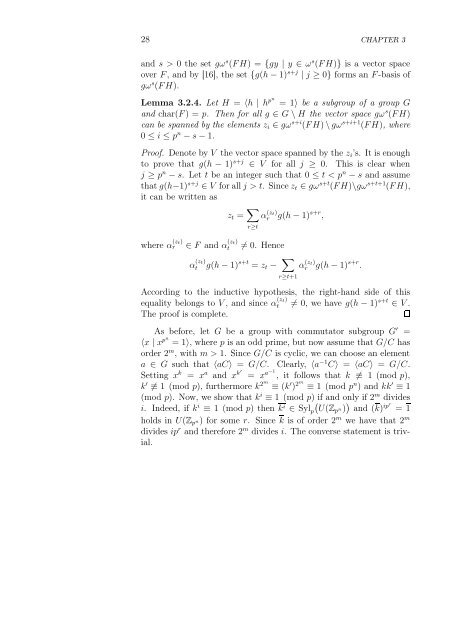On the Derived Length of Lie Solvable Group Algebras
On the Derived Length of Lie Solvable Group Algebras
On the Derived Length of Lie Solvable Group Algebras
You also want an ePaper? Increase the reach of your titles
YUMPU automatically turns print PDFs into web optimized ePapers that Google loves.
28 CHAPTER 3<br />
and s > 0 <strong>the</strong> set gω s (F H) = {gy | y ∈ ω s (F H)} is a vector space<br />
over F , and by [16], <strong>the</strong> set {g(h − 1) s+j | j ≥ 0} forms an F -basis <strong>of</strong><br />
gω s (F H).<br />
Lemma 3.2.4. Let H = 〈h | hpn = 1〉 be a subgroup <strong>of</strong> a group G<br />
and char(F ) = p. Then for all g ∈ G \ H <strong>the</strong> vector space gω s (F H)<br />
can be spanned by <strong>the</strong> elements zi ∈ gωs+i (F H) \ gωs+i+1 (F H), where<br />
0 ≤ i ≤ pn − s − 1.<br />
Pro<strong>of</strong>. Denote by V <strong>the</strong> vector space spanned by <strong>the</strong> zi’s. It is enough<br />
to prove that g(h − 1) s+j ∈ V for all j ≥ 0. This is clear when<br />
j ≥ p n − s. Let t be an integer such that 0 ≤ t < p n − s and assume<br />
that g(h−1) s+j ∈ V for all j > t. Since zt ∈ gω s+t (F H)\gω s+t+1 (F H),<br />
it can be written as<br />
where α (zt)<br />
r<br />
∈ F and α (zt)<br />
t<br />
zt = <br />
r≥t<br />
α (zt)<br />
r g(h − 1) s+r ,<br />
= 0. Hence<br />
α (zt)<br />
t g(h − 1) s+t = zt − <br />
r≥t+1<br />
α (zt)<br />
r g(h − 1)s+r .<br />
According to <strong>the</strong> inductive hypo<strong>the</strong>sis, <strong>the</strong> right-hand side <strong>of</strong> this<br />
equality belongs to V , and since α (zt)<br />
t = 0, we have g(h − 1) s+t ∈ V .<br />
The pro<strong>of</strong> is complete.<br />
As before, let G be a group with commutator subgroup G ′ =<br />
〈x | xpn = 1〉, where p is an odd prime, but now assume that G/C has<br />
order 2m , with m > 1. Since G/C is cyclic, we can choose an element<br />
a ∈ G such that 〈aC〉 = G/C. Clearly, 〈a−1C〉 = 〈aC〉 = G/C.<br />
Setting xk = xa and xk′ = xa−1, it follows that k ≡ 1 (mod p),<br />
k ′ ≡ 1 (mod p), fur<strong>the</strong>rmore k2m ≡ (k ′ ) 2m ≡ 1 (mod pn ) and kk ′ ≡ 1<br />
(mod p). Now, we show that ki ≡ 1 (mod p) if and only if 2m divides<br />
i. Indeed, if ki ≡ 1 (mod p) <strong>the</strong>n ki <br />
∈ Sylp U(Zpn) and (k) ipr = 1<br />
holds in U(Zpn) for some r. Since k is <strong>of</strong> order 2m we have that 2m divides ipr and <strong>the</strong>refore 2m divides i. The converse statement is trivial.


